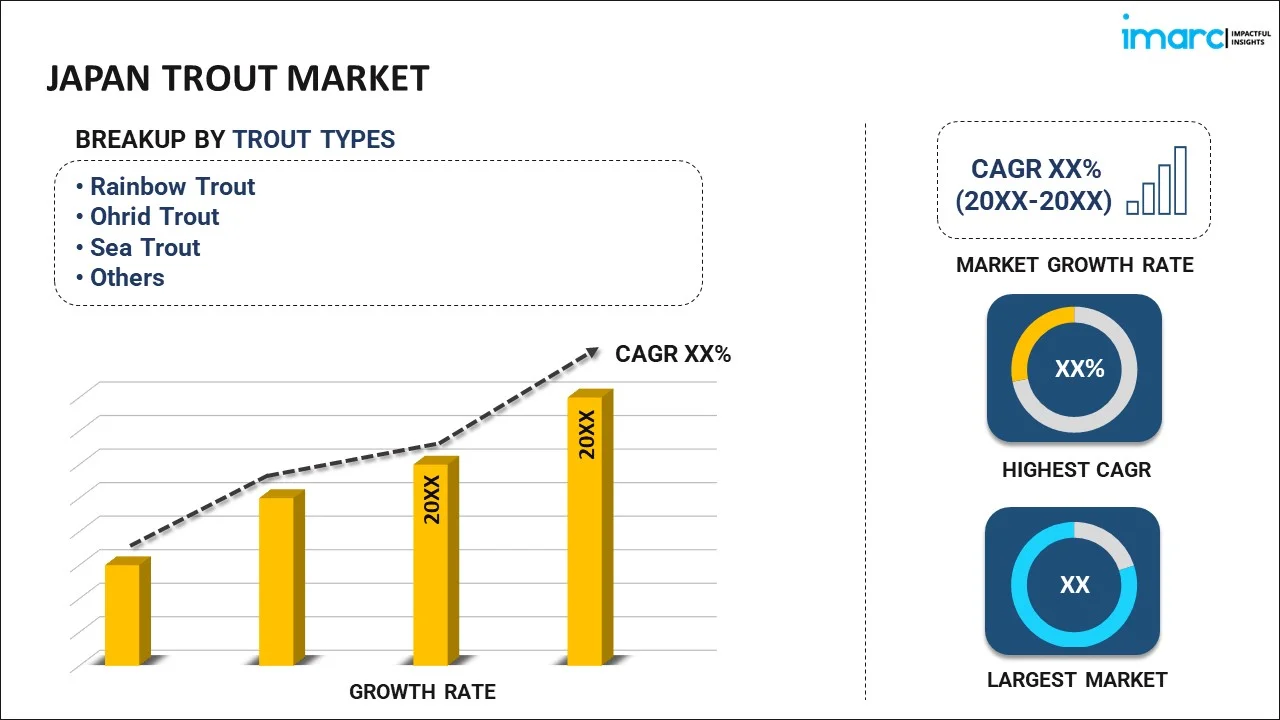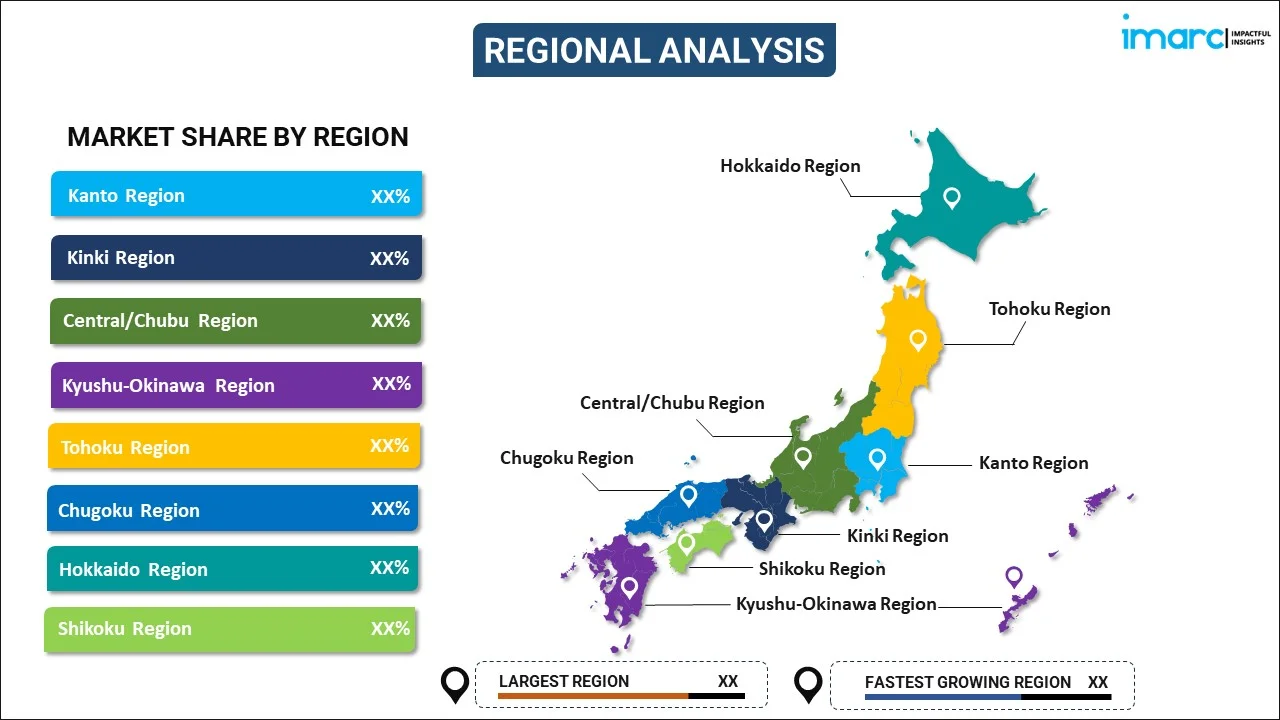
Japan Trout Market Report by Trout Type (Rainbow Trout, Ohrid Trout, Sea Trout, Golden Trout, Brook Trout, and Others), Trout Size (Large, Small), Distribution (Foodservice, Retail), Form (Fresh, Frozen, Canned, and Others), and Region 2025-2033
Market Overview:
The Japan trout market size reached USD 844.0 Million in 2024. Looking forward, IMARC Group expects the market to reach USD 1,211.6 Million by 2033, exhibiting a growth rate (CAGR) of 3.7% during 2025-2033. The rising demand for healthy and diverse protein sources, increasing awareness about the health benefits of trout, and rapid expansion in the aquaculture industry across the country represent some of the key factors driving the market.
|
Report Attribute
|
Key Statistics
|
|---|---|
|
Base Year
|
2024 |
|
Forecast Years
|
2025-2033
|
|
Historical Years
|
2019-2024
|
| Market Size in 2024 | USD 844.0 Million |
| Market Forecast in 2033 | USD 1,211.6 Million |
| Market Growth Rate (2025-2033) | 3.7% |
Trout refers to a group of freshwater fish belonging to the family Salmonidae, which includes species such as rainbow trout, brown trout, and brook trout. They are widely distributed across the Northern Hemisphere, inhabiting cold, clear streams, rivers, and lakes. Known for their vibrant colors and streamlined bodies, trout are highly esteemed for their delicate flavor, making them popular choices in the culinary world. Rainbow trout (Oncorhynchus mykiss) are among the most well-known and widely cultivated trout species. They are native to North America's Pacific Coast but have been introduced to various regions around the world due to their popularity in recreational fishing and aquaculture. Brown trout (Salmo trutta) are native to Europe and Western Asia but have also been introduced globally for sport fishing. Brook trout (Salvelinus fontinalis) are native to Eastern North America and are known for their striking colors and the beauty of their native habitats. Trout are carnivorous and primarily feed on insects, crustaceans, and smaller fish. They also possess high protein content and a notable source of essential omega-3 fatty acids, making them a nutritious option in a balanced diet. At present, trout is gaining immense traction among anglers and fish farmers across Japan as they can adapt to different environments.
Japan Trout Market Trends:
The rising demand for trout due to the Japan's rich cultural tradition of consuming seafood, as it is a freshwater fish known for its delicate flavor and nutritional value represents the primary factor driving the market growth. Apart from this, the heightening awareness about various health benefits of trout, including being rich in omega-3 fatty acids and high-quality protein, has accelerated the product adoption rate among health-conscious Japanese individuals. Moreover, the rapid expansion of Japan's well-established and efficient aquaculture industry that ensures a steady supply of locally sourced trout, meeting the escalating demand for the fish, is positively influencing the market growth. Additionally, the widespread availability of trout through various retail and distribution channels, including supermarkets, fish markets, restaurants, and online platforms, is another major growth-inducing factor. Besides this, the rapid growth in Japan’s culinary tourism scene that attracts visitors who are eager to explore authentic local cuisine and exposes more people to trout dishes has augmented the product demand. Along with this, numerous initiatives and subsidies by the government of Japan for promoting aquaculture and sustainable fishing practices by supporting fish farmers and ensuring adequate supply is propelling the market growth. Furthermore, the increasing presence of trout in Japanese cuisine, both in traditional dishes and modern culinary innovations, making it a staple choice for restaurants, seafood markets, and households, is contributing to the market growth.
Japan Trout Market Segmentation:
IMARC Group provides an analysis of the key trends in each segment of the Japan trout market report, along with forecasts at the country level for 2025-2033. Our report has categorized the market based on trout type, trout size, distribution, and form.
Trout Type Insights:

- Rainbow Trout
- Ohrid Trout
- Sea Trout
- Golden Trout
- Brook Trout
- Others
The report has provided a detailed breakup and analysis of the market based on the trout type. This includes rainbow trout, ohrid trout, sea trout, golden trout, brook, and other trout.
Trout Size Insights:
- Large
- Small
A detailed breakup and analysis of the market based on the trout size has also been provided in the report. This includes large and small.
Distribution Insights:
- Foodservice
- Retail
- Supermarkets and Hypermarkets
- Convenience Stores
- Specialty Outlets
- Online Channels
- Others
A detailed breakup and analysis of the market based on the distribution has also been provided in the report. This includes foodservice and retail (supermarkets and hypermarkets, convenience stores, specialty outlets, online channels, and others).
Form Insights:
- Fresh
- Frozen
- Canned
- Others
A detailed breakup and analysis of the market based on the form has also been provided in the report. This includes fresh, frozen, canned, and others.
Regional Insights:

- Kanto Region
- Kinki Region
- Central/ Chubu Region
- Kyushu-Okinawa Region
- Tohoku Region
- Chugoku Region
- Hokkaido Region
- Shikoku Region
The report has also provided a comprehensive analysis of all the major regional markets, which include Kanto, Kinki, Central/Chubu, Kyushu-Okinawa, Tohoku, Chugoku, Hokkaido, and Shikoku region.
Competitive Landscape:
The report has also provided a comprehensive analysis of the competitive landscape in the Japan trout market. Competitive analysis such as market structure, key player positioning, top winning strategies, competitive dashboard, and company evaluation quadrant has been covered in the report. Also, detailed profiles of all major companies have been provided.
Japan Trout Market Report Coverage:
| Report Features | Details |
|---|---|
| Base Year of the Analysis | 2024 |
| Historical Period | 2019-2024 |
| Forecast Period | 2025-2033 |
| Units | Million USD |
| Scope of the Report | Exploration of Historical and Forecast Trends, Industry Catalysts and Challenges, Segment-Wise Historical and Predictive Market Assessment:
|
| Trout Types Covered | Rainbow Trout, Ohrid Trout, Sea Trout, Golden Trout, Brook Trout, Others |
| Trout Sizes Covered | Large, Small |
| Distributions Covered | • Foodservice • Retail: Supermarkets and Hypermarkets, Convenience Stores, Specialty Outlets, Online Channels, Others |
| Forms Covered | Fresh, Frozen, Canned, Others |
| Regions Covered | Kanto Region, Kinki Region, Central/Chubu Region, Kyushu-Okinawa Region, Tohoku Region, Chugoku Region, Hokkaido Region, Shikoku Region |
| Customization Scope | 10% Free Customization |
| Post-Sale Analyst Support | 10-12 Weeks |
| Delivery Format | PDF and Excel through Email (We can also provide the editable version of the report in PPT/Word format on special request) |
Key Questions Answered in This Report:
- How has the Japan trout market performed so far and how will it perform in the coming years?
- What has been the impact of COVID-19 on the Japan trout market?
- What is the breakup of the Japan trout market on the basis of the trout type?
- What is the breakup of the Japan trout market on the basis of the trout size?
- What is the breakup of the Japan trout market on the basis of the distribution?
- What is the breakup of the Japan trout market on the basis of the form?
- What are the various stages in the value chain of the Japan trout market?
- What are the key driving factors and challenges in the Japan trout market?
- What is the structure of the Japan trout market and who are the key players?
- What is the degree of competition in the Japan trout market?
Key Benefits for Stakeholders:
- IMARC’s report offers a comprehensive quantitative analysis of various market segments, historical and current market trends, market forecasts, and dynamics of the Japan trout market from 2019-2033.
- The research study provides the latest information on the market drivers, challenges, and opportunities in the Japan trout market.
- Porter's five forces analysis assist stakeholders in assessing the impact of new entrants, competitive rivalry, supplier power, buyer power, and the threat of substitution. It helps stakeholders to analyze the level of competition within the Japan trout industry and its attractiveness.
- Competitive landscape allows stakeholders to understand their competitive environment and provides an insight into the current positions of key players in the market.
Need more help?
- Speak to our experienced analysts for insights on the current market scenarios.
- Include additional segments and countries to customize the report as per your requirement.
- Gain an unparalleled competitive advantage in your domain by understanding how to utilize the report and positively impacting your operations and revenue.
- For further assistance, please connect with our analysts.
 Inquire Before Buying
Inquire Before Buying
 Speak to an Analyst
Speak to an Analyst
 Request Brochure
Request Brochure
 Request Customization
Request Customization




.webp)




.webp)












